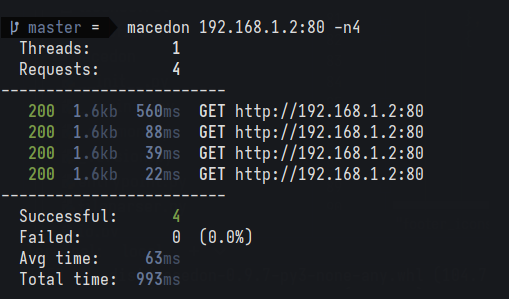CLI web service availability verifier
Project description
Multi-threaded CLI web service availability verifier. Takes a list of endpoints with optional input dataset, performs series of HTTP requests and displays the results.
Motivation
Necessity to have a fast and configurable endpoint testing tool at fingertips.
Installation
pipx install macedon
Basic usage
Configuration / Advanced usage
Usage: macedon [OPTIONS] [ENDPOINT_URL]...
Options:
-T, --threads INTEGER Number of threads for concurrent request making. Default value depends on number of
CPU cores available in the system. [default: 6]
-n, --amount INTEGER How many times each request will be performed. [default: 1]
-d, --delay FLOAT Seconds to wait between requests. [default: 0]
-t, --timeout FLOAT Seconds to wait for the response. [default: 10]
-i, --insecure Ignore invalid/expired certificates when performing HTTPS requests.
-f, --file FILENAME Execute request(s) from a specified file, or from stdin, if FILENAME specified as '-'.
The file should contain a list of endpoints in the format '{method} {url}', one per
line. Another (partially) supported format is JetBrains HTTP Client format (see
below), which additionally allows to specify request headers and/or body. The option
can be specified multiple times. Note that ENDPOINT_URL argument(s) are ignored if
this option is present.
-x, --exit-code Return different exit codes depending on completed / failed requests. With this option
exit code 0 is returned if and only if each request was considered successful (1xx,
2xx HTTP codes); even one failed request (4xx, timed out, etc) will result in a non-
zero exit code. (Normally the exit code 0 is returned as long as the application
terminated under normal conditions, regardless of an actual HTTP codes; but it can
still die with a non-zero code upon invalid option syntax, etc).
-c, --color / -C, --no-color Force output colorizing using ANSI escape sequences or disable it unconditionally. If
omitted, the application determines it automatically by checking if the output device
is a terminal emulator with SGR support.
--show-id Print a column with request serial number.
--show-error Print a column with network (not HTTP) error messages, when applicable.
-v, --verbose Increase verbosity:
-v for request details and exceptions;
-vv for request/response contents and stack traces;
-vvv for thread state transition messages.
-V, --version Show the version and exit.
--help Show this message and exit.
JetBrains HTTP Client format is described here. Also see example.http.
Proxy configuration
The application is based on Python requests library that manages all of low-level request handling, which includes proxy support, so that opens up a possibility to test the connectivity to proxies as well. Proxy configuration is done using environment variables. Below is a mini-tutorial on querying the remote server through local SOCKS proxy, but it shall work with regular HTTP/S proxies as well.
First let's create a file with request data, specifically -- with HTTP headers, as a lot of services are suspicious to the requests that came not from a regular browser, but from some custom software, and redirect them to some crazy captchas or just respond with 4XXs.
File "req1.http":
GET http://2ip.ru
User-Agent: curl/7.68.0
Accept: */*
Accept-Encoding: gzip
Now, let's perform a direct request. I added some -v options to examine the actual response from the server, which should contain our external IP address. The main reason why I'm regularly using this service -- it's the fastest way to check your external IP address from literally everywhere with just a working terminal being required, and it's very easy to memorize: curl 2ip.ru.
$ macedon -T1 -f req1.http -vvv
...
200 16b 105ms GET http://2ip.ru
[ 100% 1/1 ] [INFO ][macedon:#0](+201ms) Response #1 metadata: 200 {'Server': 'nginx', 'Date': 'Fri, 09 Jun 2023 14:44:23 GMT', 'Content-Type': 'application/octet-stream', 'Content-Length': '16', 'Connection': 'keep-alive'}
[TRACE][macedon:#0](+201ms)
Response #1 content:_____________________________________________________
0 |U+ 31 38 35 2E 32 34 33 2E 32 31 38 2E 31 35 32 0A |185.243.218.152↵
----------------------------------------------------------------------(16)
...
Direct requests work, yay. Next, to use a proxy server define the environment variables HTTP_PROXY and HTTPS_PROXY in the following format:
$ export HTTP_PROXY="http://<user>:<pass>@<proxy>:<port>"
$ export HTTPS_PROXY="http://<user>:<pass>@<proxy>:<port>"
Needless to say that you shall put the real credentials instead of placeholders, but just in case...
Personally I prefer another method: prepending the command with an environment variable, which sets it as well, but for the one command only. Let's try it:
$ HTTP_PROXY=socks5h://localhost:1080 macedon -f req1.http -vvv
...
200 14b 964ms GET http://2ip.ru
[ 100% 1/1 ] [INFO ][macedon:#0](+1.06s) Response #1 metadata: 200 {'Server': 'nginx', 'Date': 'Fri, 09 Jun 2023 14:49:24 GMT', 'Content-Type': 'application/octet-stream', 'Content-Length': '14', 'Connection': 'keep-alive'}
[TRACE][macedon:#0](+1.07s)
Response #1 content:_______________________________________________
0 |U+ 32 33 2e 31 32 39 2e 36 34 2e 31 33 32 0a |23.129.64.132↵
---------------------------------------------------------------(14)
The service now sees that we made a request from another address and reflects that in his response. Furthermore, the latency drastically increased from 105 ms to almost 1 second, which can also be considered as confirmation of successful proxying the request.
There is also a possibility to encounter errors while attempting to connect through SOCKS proxy (HTTP proxies unaffected), which usually look like this: [ERROR][macedon:#0](+92.9ms) Missing dependencies for SOCKS support (sigh). Well, there is an easy solution for this: just install the missing depenedencies:
pipx inject macedon requests[socks]
This is an optional dependency and due to this it's not installed by default. If pipx is not present, it's also can be done manually with venv/bin/pip (assuming the virtualenv is being used instead).
Changelog
Project details
Release history Release notifications | RSS feed
Download files
Download the file for your platform. If you're not sure which to choose, learn more about installing packages.




















